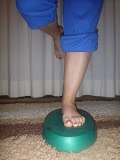Sciatica is pain caused by irritation of the sciatic
nerve. The irritated nerve causes pain that runs down your leg from your
lower back or hip.
How does it occur?
The sciatic nerve is
formed by a group of nerves that run from the lower spine down the leg
to the foot. Anything that irritates the nerve can cause sciatica. The
most common causes are:
overuse of your back (lifting something that is too heavy or doing work that uses your back much more than you are used to)
injury to your back (slipping and falling, or having something hit your back).
Overuse or injury can cause muscle tension or spasm, back sprains,
ligament or muscle tears, or joint problems, all of which can irritate
the sciatic nerve.
Low back pain and sciatica can also be caused by
infections, tumors, a ruptured (herniated) disk in your back,
osteoporosis, spondylosis (hardening and stiffening of the spine), or
spinal stenosis (a narrowing of the spinal canal that squeezes the
spinal cord and nerves).
What are the symptoms?
The main symptom is pain that shoots down from the lower back and buttocks to your leg.
You may also have numbness or tingling in your leg.
Sometimes your leg muscles are weak.
How is it diagnosed?
Your healthcare provider will ask about your symptoms and examine your
back. If your provider thinks you might have an infection or a bone
disease, you may have some lab tests or X-rays, a CT scan, or an MRI.
Most people do not need X-rays or other types of scans in the early part
of their treatment. If the pain does not get better in a few weeks, or
if the symptoms get worse, then special tests may be needed
How is it treated?
Most people with low back pain and sciatica get better no matter what they do.
Acetaminophen may help decrease your pain. Often nonprescription
nonsteroidal anti-inflammatory drugs (NSAIDs) such as aspirin,
ibuprofen, and naproxen can help relieve pain and inflammation. These
NSAIDs may be bought with or without a prescription. Check with your
healthcare provider before you give any medicine that contains aspirin
or salicylates to a child or teen. This includes medicines like baby
aspirin, some cold medicines, and Pepto-Bismol. Children and teens who
take aspirin are at risk for a serious illness called Reye's syndrome.
NSAIDs help reduce pain and swelling but may cause stomach bleeding and
other problems. These risks increase with age. Read the label and take
as directed. Unless recommended by your healthcare provider, do not take
NSAIDs for more than 10 days for any reason. Talk to your healthcare
provider about whether you should take these medicines.
Your
provider may prescribe stronger pain medicine or other types of
medicines. Your provider may prescribe oral steroids or you may be given
a steroid shot into your spine to control pain and inflammation.
Your provider may also suggest physical therapy. A program of gentle stretching and exercise may speed your recovery.
If you keep having symptoms, you may need to have surgery for a
ruptured disk. However, most people who have ruptured disks do not need
an operation.
How can I take care of myself?
If you have
low back pain and sciatica, make sure you do not overuse your back.
Strict bed rest is no longer recommended. It is better to do your usual
activities but:
Avoid lifting more than 5 pounds.
Avoid frequent bending or other activities that make the pain worse.
Ice packs or a heating pad may help reduce pain. Don’t sleep on a heating pad because it could cause burns.
When you sleep on your side, put a pillow between your knees. If you
sleep on your back, put a pillow under your knees. Try to avoid sleeping
on your stomach.
Change your position often throughout the day. Try
to alternate sitting and standing. If you must stand for a long time,
try putting one foot on a low stool.
If you smoke, stop. Smoking
decreases blood flow to muscles and disks in and around your spine.
Injuries take longer to heal in people who smoke.
Contact your healthcare provider right away if:
You have numbness or tingling in the inner part of your thighs.
You have new or increasing weakness in your legs.
Call your provider for a follow-up appointment if:
The pain is not getting better.
You have new symptoms.
How can I help prevent sciatica?
If you have had back pain and sciatica, you are likely to get it again. To help keep from having it again:
Lose weight if you are overweight.
Do regular aerobic exercise to keep your back and abdominal muscles in shape (this can be as simple as walking),
Do stretching exercises before participating in activities.
Learn to lift properly. Bend your knees and hips and keep your back straight when you lift a heavy object.
Practice good posture. Stand with your head up, shoulders straight,
chest forward, weight balanced evenly on both feet, and pelvis tucked
in.

https://www.facebook.com/PhysiotherapyCzech





























